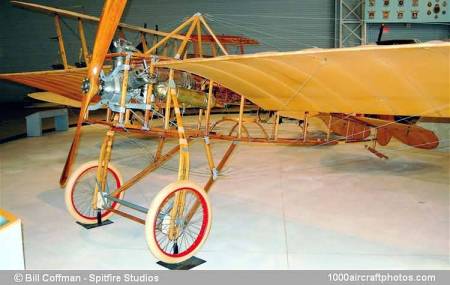McDowall returned home and designed an aircraft to take the engine, and he, together with his cousin George A. Ferguson, began to build it in the winter of 1911-1912. Construction was at Morrishes Foundry & Machine Shop, Owen Sound, owned by his uncle and George's father, William Ferguson. The work proceeded slowly as a part-time project in the winters only, so it was not completed until the summer of 1915. Fuel and oil tanks and, probably, the wheels had been purchased from a New York aeronautical supply house, and Irish linen to cover the surfaces had been bought during a trip to Ireland.
While in recent years the aircraft has often been referred to as a 'Blériot monoplane', in fact no part of it resembled a Blériot XI. The McDowall was smaller, its tail plane and elevator were of more modern design, the landing gear, with its rubber shock absorber, and all components were quite different. However, it was a wire-braced high-wing monoplane like the Blériot XI and a good many other monoplanes of the period, and it did use wing warping for lateral control. The whole fuselage was left uncovered.
The finished aircraft was taken to the nearby farm of John Riddell, McDowall's mother's uncle, for testing. Robert McDowall made several attempts to fly it during the summer but it seems that none was successful although 'hops' were apparently made. The machine was then returned to the Morrishes Foundry and hung from the ceiling.
There it was discovered, apparently in 1916 or 1917, by two schoolboys, L.R.C. McAteer and J.P. Middlebro, who got permission to try it. They installed a new jet in a carburetor taken from a Maxwell car and this added 150 rpm. They then reduced the propeller diameter to enable the engine to produce its full revolutions. Next they planned to replace the wing-warping system with ailerons and the trailing edge was cut away at the wing tips to receive them; these were not fitted and the machine was again stored.
In 1920, apparently, Edward Pratt of Durham, Ontario, who was attending business college at Owen Sound, bought the machine and transported it to Durham by sleigh. He replaced the wheels by skis and used it, without wings, as an ice scooter on nearby MacLean's Lake. For protection from the slipstream a sheet-metal shield was fitted around the driver's position.
In the spring of 1958, Keith S. Hopkinson of Sky Harbour Air Services, Godrich, Ontario, bought the aircraft, and it hung from his hangar ceiling until sold to the National Aviation Museum in the spring of 1967 and taken to Ottawa. There it remains, still unrestored, the oldest surviving Canadian-built aircraft although it appears never to have made a full-fledged flight.
Span: 27 ft 6 in (8.38 m)
Length: 21 ft 6 in (6.55 m)
Height: 7 ft 5 in (2.26 m)
Wing area: 139.6 sq.ft (12.97 sq.m)
